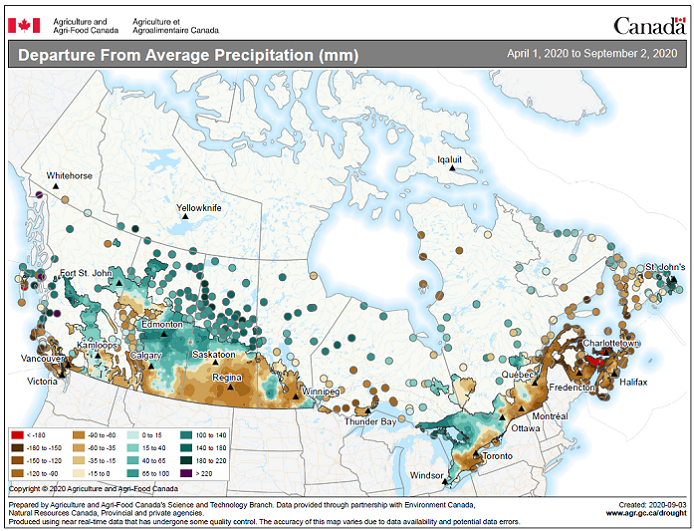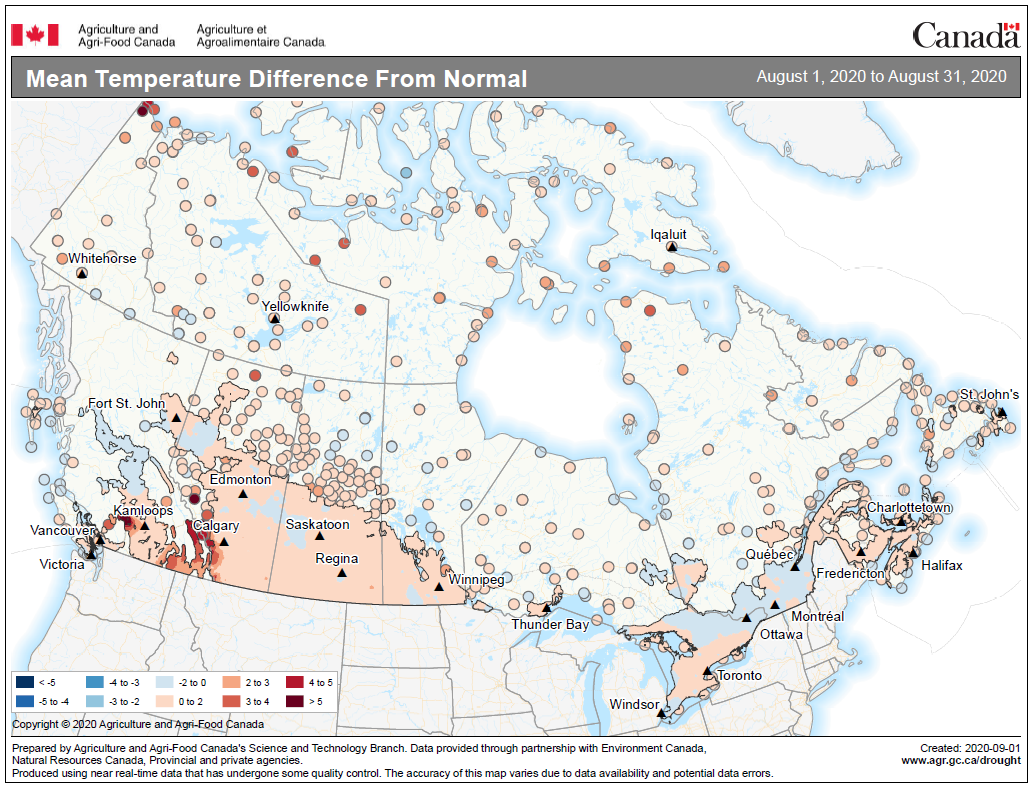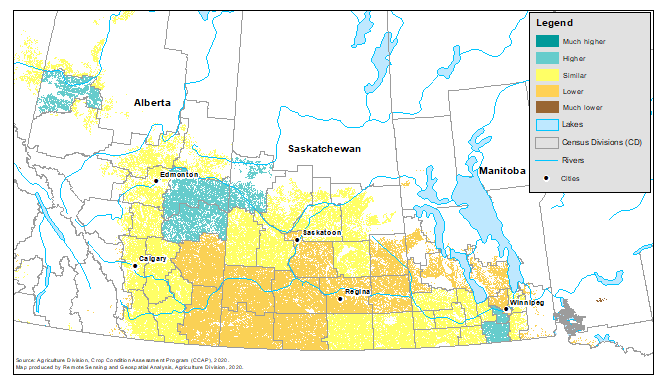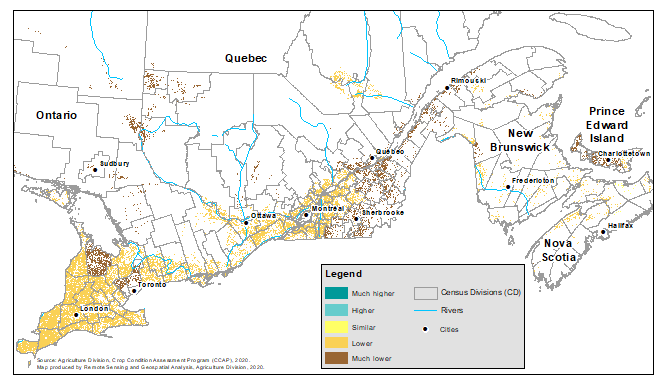Model-based principal field crop estimates, August 31, 2020
Archived Content
Information identified as archived is provided for reference, research or recordkeeping purposes. It is not subject to the Government of Canada Web Standards and has not been altered or updated since it was archived. Please "contact us" to request a format other than those available.
Released: 2020-09-14
Canadian farmers are projected to harvest more wheat, corn for grain, soybeans, and oats this fall compared with last year, but less barley and canola according to recent yield models using satellite technology.
Statistics Canada has relied upon proven satellite technology to model preliminary crop yields and harvests since 2016.
Farmers on parts of the Prairies have had to contend with excessive rain and lower than average temperatures in the early part of the summer and above average temperatures in August, while it has been hot and dry throughout southern Ontario and the Maritimes. These variable weather conditions have put downward pressure on some of the yield estimates.
The Crop Condition Assessment Program data published by Statistics Canada indicate that overall plant health in the Prairie provinces was equal to or much higher than normal for most of the region. Conversely, plant health in Eastern Canada is, for the most part, average, likely due in part to the lack of rain.
Wheat production expected to increase on higher harvested area and yields
Nationally, wheat production is projected to increase 5.6% year over year to 34.1 million tonnes in 2020, on higher anticipated yields (+3.2% to 51.4 bushels per acre) and more harvested area (+2.3% to 24.4 million acres).
The increase in wheat area was largely attributable to durum wheat and winter wheat remaining after winterkill, which offset the expected decrease in spring wheat area.
Wheat yield in Saskatchewan is expected to increase 1.4% to 45.0 bushels per acre in 2020, while harvested area is projected to edge up 0.4%, resulting in a 1.9% production increase to 15.4 million tonnes.
Harvested area is expected to edge up 0.2% to 7.2 million acres in Alberta, while yields are anticipated to rise 4.4% to 54.6 bushels per acre to bring total wheat production up 4.6% year over year to 10.7 million tonnes.
Wheat production in Manitoba is projected to decline 0.6% to 4.9 million tonnes in 2020, the result of lower yields (-1.3% to 59.0 bushels per acre), despite an increase in harvested area (+0.8% to 3.1 million acres).
Wheat production in Ontario (the majority of which is winter wheat) is projected to rise by 65.0% year over year, to 2.5 million tonnes, on increased harvested acres (+53.1%) and yields (+7.8%). The expected increase in harvested area was attributable to less winterkill due to a mild winter in the province.
Canola production projected to decrease both on higher yields and lower harvested area
Nationally, canola production is expected to fall 0.4% to 19.4 million tonnes in 2020, with higher yields (+1.2% to 41.6 bushels per acre) and lower harvested area (-1.6% to 20.6 million acres).
Saskatchewan, the largest canola producing province, is expected to produce 7.7% less canola in 2020, at 10.1 million tonnes. Yields are projected to decrease 3.9% to 39.6 bushels per acre, while harvested area is expected to fall 3.9%.
In Alberta, yield is expected to rise 12.7% to 45.4 bushels per acre and harvested area to fall 0.3% to 5.8 million acres, resulting in a 12.4% production increase.
Canola production in Manitoba is expected to increase 3.5% to 3.2 million tonnes. The projected decrease in yields (-0.7% to 41.7 bushels per acre) is expected to marginally offset the increase in harvested area (+4.3% to 3.3 million acres).
Corn for grain production projected to increase on higher yields
Nationally, corn for grain production is projected to rise 4.7% to 14.0 million tonnes in 2020, with the anticipated increase in yield (+8.3% to 159.4 bushels per acre) offsetting lower harvested area (-3.4% to 3.5 million acres).
In Ontario, the largest corn for grain producing province, production is expected to increase 1.8% to 8.8 million tonnes, on higher harvested area (+0.3% to 2.2 million acres) and yields (+1.5% to 160.8 bushels per acre).
Corn for grain production in Quebec is projected to rise 8.8% to 3.7 million tonnes. Yields in Quebec are expected to rise 15.3% to 163.1 bushels per acres, while harvested area is expected to fall 5.7% to 885,000 acres.
Soybean production expected to increase
Soybean production nationally is projected to increase 1.5% year over year to 6.1 million tonnes in 2020 despite lower harvested area (-12.5% to 4.9 million acres). Yields are expected to increase 15.9% to 45.9 bushels per acre.
Farmers in Ontario are projected to produce the same amount of soybeans in 2020 at 3.7 million tonnes. Harvested area is expected to fall 8.0% to 2.8 million acres, while yield is anticipated to rise 8.8% to 48.0 bushels per acre.
In Manitoba, soybean production is projected to increase 4.6% to 1.2 million tonnes in 2020. Harvested area is projected to decrease 19.7% to 1.1 million acres, likely attributable to Manitoba farmers reducing seeded area following several years of lower yields due to dry conditions. However, yields are projected to rise 30.1% year over year to 38.0 bushels per acre this year, reversing the trend.
In Quebec, soybean production is projected to increase 14.2% to 1.2 million tonnes on sharply higher yields (+16.9% to 49.8 bushels per acre), which will more than offset the projected 2.4% decrease in harvested area.
Barley production projected to fall while oats rise
Barley production is expected to decline 1.2% year over year to 10.3 million tonnes in 2020, with lower yields (-2.4% to 69.1 bushels per acre) offsetting the increase in harvested area (+1.1% to 6.8 million acres).
Oat production is projected to rise 6.5% to 4.5 million tonnes. Harvested area is expected to increase 6.7% to 3.1 million acres and yields are expected to edge down by 0.2% year over year to 94.9 bushels per acre in 2020.
Note to readers
Model-based principal field crop estimates are calculated according to an approach developed by Statistics Canada in close partnership with Agriculture and Agri-Food Canada. These yield estimates are based on a model that incorporates coarse resolution satellite data from Statistics Canada's Crop Condition Assessment Program, data from Statistics Canada's field crop reporting series, and agroclimatic data.
A methodology report describing the original yield model used at Statistics Canada is available online.
In July 2019, an extended yield model based on parcel level crop insurance data received from Manitoba Agriculture Services Corporation was used for Manitoba. For more information regarding the extended yield model, please visit An Integrated Crop Yield Model Using Remote Sensing, Agroclimatic Data and Crop Insurance Data.
Production estimates for Quebec, Ontario, Manitoba, Saskatchewan and Alberta are calculated using the model-based yields as of August 31, multiplied by the reported harvested area from the July Farm Survey of the field crop reporting series. Estimates for Prince Edward Island, Nova Scotia, New Brunswick, and British Columbia are carried forward from the July estimates of production of principal field crops.
Final crop production estimates for the current year will be released on December 3.
Contact information
For more information, or to enquire about the concepts, methods or data quality of this release, contact us (toll-free 1-800-263-1136; 514-283-8300; STATCAN.infostats-infostats.STATCAN@canada.ca) or Media Relations (613-951-4636; STATCAN.mediahotline-ligneinfomedias.STATCAN@canada.ca).
- Date modified:





